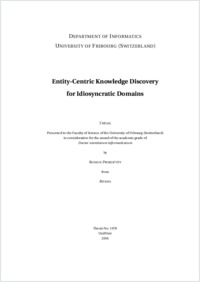Entity-centric knowledge discovery for idiosyncratic domains
- Prokofyev, Roman
- Cudré-Mauroux, Philippe (Degree supervisor)
-
2016
1 ressource en ligne (94 p.)
Thèse de doctorat: Université de Fribourg, 2016
English
Technical and scientific knowledge is produced at an ever-accelerating pace, leading to increasing issues when trying to automatically organize or process it, e.g., when searching for relevant prior work. Knowledge can today be produced both in unstructured (plain text) and structured (metadata or linked data) forms. However, unstructured content is still themost dominant formused to represent scientific knowledge. In order to facilitate the extraction and discovery of relevant content, new automated and scalable methods for processing, structuring and organizing scientific knowledge are called for. In this context, a number of applications are emerging, ranging fromNamed Entity Recognition (NER) and Entity Linking tools for scientific papers to specific platforms leveraging information extraction techniques to organize scientific knowledge. In this thesis, we tackle the tasks of Entity Recognition, Disambiguation and Linking in idiosyncratic domains with an emphasis on scientific literature. Furthermore, we study the related task of co-reference resolution with a specific focus on named entities. We start by exploring Named Entity Recognition, a task that aims to identify the boundaries of named entities in textual contents. We propose a newmethod to generate candidate named entities based on n-gram collocation statistics and design several entity recognition features to further classify them. In addition, we show how the use of external knowledge bases (either domain-specific like DBLP or generic like DBPedia) can be leveraged to improve the effectiveness of NER for idiosyncratic domains. Subsequently, we move to Entity Disambiguation, which is typically performed after entity recognition in order to link an entity to a knowledge base. We propose novel semi-supervised methods for word disambiguation leveraging the structure of a community-based ontology of scientific concepts. Our approach exploits the graph structure that connects different terms and their definitions to automatically identify the correct sense that was originally picked by the authors of a scientific publication. We then turn to co-reference resolution, a task aiming at identifying entities that appear using various forms throughout the text. We propose an approach to type entities leveraging an inverted index built on top of a knowledge base, and to subsequently re-assign entities based on the semantic relatedness of the introduced types. Finally, we describe an application which goal is to help researchers discover and manage scientific publications. We focus on the problem of selecting relevant tags to organize collections of research papers in that context. We experimentally demonstrate that the use of a community-authored ontology together with information about the position of the concepts in the documents allows to significantly increase the precision of tag selection over standard methods.
- Faculty
- Faculté des sciences et de médecine
- Language
-
- English
- Classification
- Applied sciences
- Notes
-
- Ressource en ligne consultée le 12.06.2017
- License
-
License undefined
- Identifiers
-
- RERO DOC 288938
- URN urn:nbn:ch:rero-002-116262
- RERO R008665243
- Persistent URL
- https://folia.unifr.ch/unifr/documents/305608
Statistics
Document views: 300
File downloads:
- Texte intégral: 211
